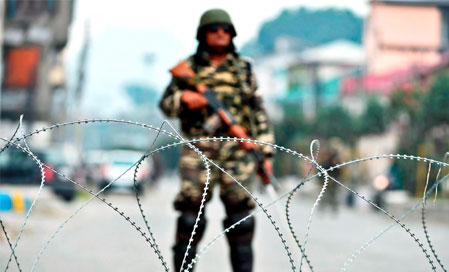Geopolitics In The Triple Border Of Kashmir: Conflicts Between China, Pakistan, And India Conflicts Between China, Pakistan, And India
Main Article Content
Keywords
China, Pakistan, India, Geopolitics, Kashmir region, China-Pakistan Economic Corridor, New Silk Road, BRICS
Abstract
The article addresses, from a historical and geopolitical perspective, the past and current conflicts between China, Pakistan, and India in the triple border of Kashmir; calling attention to its particularity as a geostrategic area. It analyzes the military confrontations and disagreements between China and India; developing an interpretative historical framework that provides elements to understand the relevance of the conflicts in the region. It examines in detail the dispute between India and Pakistan, as part of the British legacy, where ethnic differences are highlighted as a key factor to understand the depth of the problem. It analyzes how the conflicts in Kashmir can be an element that leads the mechanism of the BRICS and the New Silk Road to a possible failure. The increase in conflicts would further involve Russia, the United States, Japan, Australia, Israel, among others.
Downloads
References
Anuario Internacional CIDOB (2012b). Perfil de País: Relaciones Exteriores de Pakistán. España, CIDOB, 431-439.
Brzezinski, Z. (1997). The Grand Chessboard. American primacy and its geoestrategic imperatives. Nueva York: Basic Books.
CIEE (2017). Editorial. El elefante y el dragón: las aspiraciones de los gigantes asiáticos. Newsletter. CIEEANEPE, núm. 13, noviembre, 1-1.
Esteve, J. E. (2008). La disputa fronteriza entre India y China: origen y evolución de la controversia. Revista electrónica de Estudios Internacionales, núm. 16, 1-23.
Gómez, A. (2016). Cachemira, la región más codiciada de Asia. Documento de Opinión Instituto Español de Estudios Estratégicos, 782-798.
Johns Hopkins (7 September 2020). Coronavirus Resource Center. Recuperado de https://coronavirus.jhu.edu/map.html. Consultado el 23 de abril de 2021.
Kanwal, G. (2017). El sur de Asia se calienta: una perspectiva india. Newsletter. CIEE-ANEPE, núm. 13, noviembre, 6-12.
Mackinder, H. (1904). The Geographical pivot of History. Geographical Journal, vol. 170, no. 4, 298-321
Mahan, A. (2007). Influencia del poder naval en la historia. España: Ministerio de Defensa.
Malik, M. (2017). China e Inda: la raíz de las hostilidades. Newsletter. CIEE-ANEPE, núm. 13, noviembre, 2-6.
Ministry of External Affairs Government of India (12 October 2019). 2nd India-China Informal Summit. Recuperado de: https://www.mea.gov.in/press-releases.htm?dtl/31938/2nd_IndiaChina_Informal_Summit. Consultado el: 5 de mayo de 2020.
Ministry of External Affairs Government of India (28 April 2018). India-China Informal Summit at Wuhan. Recuperado de: https://mea.gov.in/press-releases.htm?dtl/29853/IndiaChina_Informal_Summit_at_Wuhan. Consultado el: 5 de mayo de 2020.
Pardo, J. M. (2019a). El conflicto fronterizo entre India y China. Arunachal Pradesh. Documento de Opinión Instituto Español de Estudios Estratégicos, 31 de enero, 1-15.
Pardo, J. M. (2019b). El conflicto fronterizo entre India y China, Doklam. Implicaciones geoestratégicas. Documento de Opinión Instituto Español de Estudios Estratégicos, 9 de mayo, 1-15.
Pardo, J. M. (2018). El conflicto fronterizo entre India y China. Aksai Chi. Documento de Opinión Instituto Español de Estudios Estratégicos, 12 de octubre, 1-24.
Portador, T. y O. Solórzano (2019). Soft power y nueva diplomacia china en el siglo XXI con países del sur global: el caso latinoamericano. MAP Revista Mundo Asia Pacífico, vol. 8, núm. 14, Colombia, enero-junio, 28-44.
Rifaat, H. y T. Singh (2016). The China-Pakistan Economic Corridor. Strategic rationales, external perspectives, and challenges to effective implementation. USA: Stimson Center.
Ross, C. (2010). La política exterior India durante la Guerra Fría. Revista Universum, Universidad de Talca, vol. 1, núm. 25, 152-173.
Silvela, E. y F. Vacas (2006). El conflicto de India y Paquistán. España: Ministerio de Defensa/Instituto de Estudios Internacionales y Europeos Francisco De Vitoria Universidad Carlos III.
Solórzano, O. y T. Portador (2018). La geopolítica en la Península Coreana. Revista Relaciones Internacionales de la Escuela de Relaciones Internacionales de la Universidad Nacional Costa Rica, núm. 91.2, julio-diciembre, 1-14.
Solórzano, O. (2016). Respuestas y desafíos de la sociedad global en la era de la globalización. Ad Universa Revista de Relaciones Internacionales, vol. 01, núm. 13, año 07, diciembre, 64-77.
Ternicien, J. P. (2020). Conflicto India-China en la región de Cachemira. Revista de Marina, 11 de junio, 1-4.
Tugores, J. (2006). Economía internacional. Globalización e integración regional. España: McGraw-Hill.
Wang, O. (4 September 2020). Xi Jinping calls for freer service trade as China tries to counter decoupling. Recuperado de: https://www.scmp.com/news/china/article/3100335/xi-jinping-calls-freer-service-tradechina-tries-counter-decoupling. Consultado el 5 de septiembre de 2020.
Yeung, K. (5 September 2020). India to blame for border tensions, Chinese defense chief Wei Fenghe says, en South China Morning Post. Recuperado de: https://www.scmp.com/news/china/diplomacy/article/3100359/india-blame-border-tensions-chinese-defence-chief-wei-fenghe. Consultado el 6 de septiembre de 2020.

